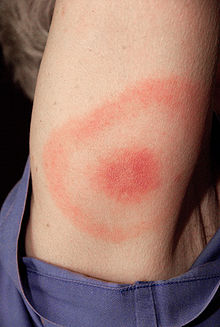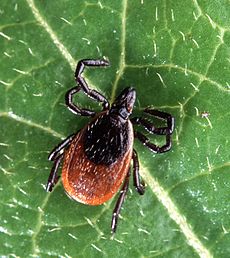
Singer Avril Lavigne has described her struggle with Lyme disease as the ‘worst time’ of her life.
The disease, spread when you get bitten by an infected tick, can result in extreme tiredness and flu like symptoms and it can be hard to diagnose. If left untreated serious illness can occur.
Lavigne, who has sold more than 30 million albums worldwide, believes she contracted Lyme disease whilst touring in 2014. The Canadian became bed-ridden in October, but is now expected to make a full recovery, although diagnosis took many months in her case.
Some 2,000 to 3,000 cases of Lyme Disease are reported to the NHS each year in England and Wales, only about 15 per cent of which are contracted overseas.
Signs of Lyme Disease
 Many people with early-stage Lyme disease develop a distinctive circular rash at the site of the tick bite, usually around 3 to 30 days after being bitten. This is known as erythema migrans – see http://www.nhs.uk/Conditions/Lyme-disease/Pages/Introduction.aspx .
Many people with early-stage Lyme disease develop a distinctive circular rash at the site of the tick bite, usually around 3 to 30 days after being bitten. This is known as erythema migrans – see http://www.nhs.uk/Conditions/Lyme-disease/Pages/Introduction.aspx .
The rash is often described as looking like a bull’s-eye on a dart board. The affected area of skin will be red and the edges may feel slightly raised. The size of the rash can vary significantly and it may expand over several days or weeks. Typically it’s around 15cm (6 inches) across, but it can be much larger or smaller than this. Some people may develop several rashes in different parts of their body. However, around one person in every three with Lyme disease won’t develop this rash. Some people with Lyme disease also experience flu-like symptoms in the early stages, such as tiredness (fatigue), muscle pain, joint pain, headaches, a high temperature (fever), chills and neck stiffness.
How you get Lyme Disease
 If a tick bites an animal carrying the bacteria that cause Lyme disease (Borrelia burgdorferi), the tick can also become infected. The tick can then transfer the bacteria to a human by biting them.
If a tick bites an animal carrying the bacteria that cause Lyme disease (Borrelia burgdorferi), the tick can also become infected. The tick can then transfer the bacteria to a human by biting them.
Ticks can be found in any areas with deep or overgrown vegetation where they have access to animals to feed on. They’re common in woodland and heath areas, but can also be found in gardens or parks. Ticks don’t jump or fly, but climb on to your clothes or skin if you brush against something they’re on. They then bite into the skin and start to feed on your blood.
Generally, you’re more likely to become infected if the tick remains attached to your skin for more than 24 hours. But ticks are very small and their bites are not painful, so you may not realise you have one attached to your skin.
Who’s at risk and where are ticks found?
People who spend time in woodland or heath areas in the UK and parts of Europe or North America are most at risk of developing Lyme disease. Most tick bites happen in late spring, early summer and autumn because these are the times of year when most people take part in outdoor activities, such as hiking and camping. Cases of Lyme disease have been reported throughout the UK, but areas known to have a particularly high population of ticks include:
Exmoor
The New Forest and other rural areas of Hampshire
The South Downs
Parts of Wiltshire and Berkshire
Parts of Surrey and West Sussex
Thetford Forest in Norfolk
The Lake District
The North York Moors
The Scottish Highlands
It’s thought only a small proportion of ticks carry the bacteria that cause Lyme disease, so being bitten doesn’t mean you’ll definitely be infected. However, it’s important to be aware of the risk and seek medical advice if you start to feel unwell.
Source: www.nhs.uk
Pics: Wiki






































